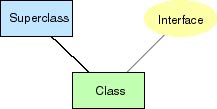There is a good deal of "magic" involved in how
an event is actually dispatched. In general, the processEventType
method in the component object calls a particular method in
the receiving object appropriate for the particular type of
event. Thus, different methods are called, for example, when
the mouse is moved (button up) versus when it is dragged
(button down). How can the component object know which
methods in the receiving object to call?
The answer lies in the concept of a Java Interface.
Much has been made of the fact that Java does not allow
multiple inheritance. Thus, a given class can be the subclass
of at most one other class. It cannot inherit from two
classes. However, it is able to achieve some of the benefits
of multiple inheritance thorough Interfaces. An
interface is a specification for a set of methods and
variables. A class can elect to implement the
interface, committing it to including within its definition
all of the methods and variables specified in the interface.
Then, if some method in another class wishes to communicate
with such an object, it can do so through the methods or
variables designated in the interface since it knows that
they will be present in the object.

Inheritance vs. Interface.
Thus, in the Button class, the processActionEvent
method can communicate with all registered objects through an
actionPerformed method that is included in each
such object by virtue of their commitments to implementing
the actionListener
interface.
The complete set of event interfaces for AWT components is
included in the java.awt.event
package.